A History of the Headdress
"Tiara wearing
is joyous, fun, and feminine"
![]()
It could never be definitively stated when
the first person decided to place an ornament on their head - but being
always on show, the head is an obvious place to place something that denotes
joy, wealth or status, but the first known recorded or tangible items of
head-jewellery have been found on Egyptian mummies and to this day, the
Roman laurel-wreath head-dress is given to winners in the garlands (now
worn around the neck) displayed by winning F1 racing drivers.
It could be that Marie Antoinette, with her huge beehive up-do's showcasing
precious jewels, may be the fore-running innovator for the modern tiara;
crowns and coronets have long been worn by heads of state indicating power
and status and these are recorded into antiquity, the story of King Henry
VIII's ancestor Henry Tudor finding the crown of Richard III in a hawthorn
bush and claiming kingship demonstrates the symbolism of crowns.
The design of the tiara as opposed to the crown could be suggested by the
wearing of ornaments such as necklaces or brooches in the hair of fashionable
women...it is not a large leap of imagination to consider a court jeweller
combining such jewellery into a band for easier wearing.
The changes in time in hairstyles and head-dresses relate to the complexity
of the social dictums of different courts; Marie Antoinette reflected the
news of the time by referencing contemporary events in her hairstyle and
ornaments - take for instance the famous 'ship' coiffure.
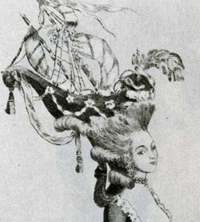
Marie Antoinette and her 'Ship' Coiffure - perhaps the most whimsical
tiara in the world??
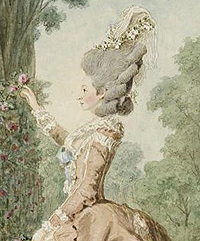
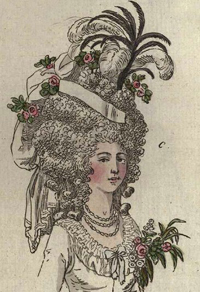
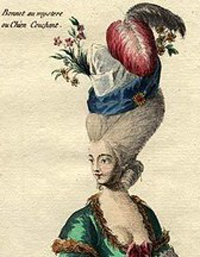
Above - Ladies of High Fashion
Despite all her wealth and status, at her marriage to Prince
Albert in 1847, Queen Victoria wore a wreath of simple orange blossom and
wax flowers...the wearing of flowers and simple jewels rather than those
of state seeming to signify romance and innocence. Just like the manner
in which Prince Albert established the custom of bringing a Christmas Tree
into one's home, it could be argued that this wedding was the starting point
of bridal headwear (and also the start of the tradition of the wearing of
white by a bride - before this a bride would simply wear her best dress),
at a time when jewellery spelt out hidden meanings and flowers had their
own language, this was a time of high romance.
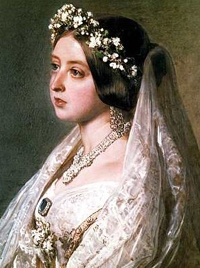
Above - Queen Victoria in Her Bridal Finery
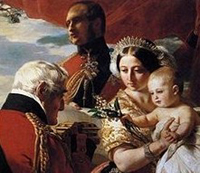
Above - Victoria in a Kokoshnik style tiara
Victoria was not only influential in the colour of her wedding
dress and the simplicity of her bridal head-dress; when her beloved husband's
life was cut short, she went into deep mourning for the remainder of her
life which ensued the wearing of black jewellery and black tiaras - bog
oak, Whitby jet, enamel and cut steel were some of the materials used, as
the cult of mourning seemed to take over the entire way of Victorian life.
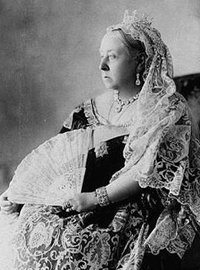
Above: Empress Queen Victoria in old age
Whilst a bride might opt at the time of her wedding for simplicity
and that might be the only time in her life when she might wear a circlet
or tiara, court jewellery was abundantly magnificent, sparkling rose cut
diamonds mixed with stunning sapphires, ruby and emeralds, every woman of
means and title would have a number of tiaras and crowns to wear to glittering
social occasions; many of these would be periodically broken down and remade
into new designs as fashions changed and many of these same tiaras or crowns
would be in fact made of several elements which could be disassembed and
worn as necklaces, earrings and brooches before being put back together
as the tiara - can you imagine the fuss which may have ensued if a piece
was lost at a ball?
When considering the wearing of tiaras and head-dresses it is worth remembering
the importance of jewels of Indian Princes who wore astonishing adornments
pinned to their head-wear, the influence of coloured stones such as emeralds,
rubies and sapphires from these parts are evident in the crown jewels of
today and all these pieces would be no-where as magnificent without the
influence of colour.
Equally influential was the Russian and Eastern European royal families
who traditionally wore a flattering face-framing band or tiara which was
named 'kokoshnik', again the input of colour rather than a traditional blaze
of diamonds can perhaps be said to be the abiding influence of this culture;
court jewellers such as Faberge are noted for their innovative use of colour
and enamelling in jewellery.
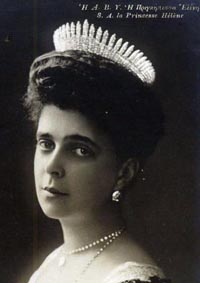
Above and Below - Kokoshnik style tiara
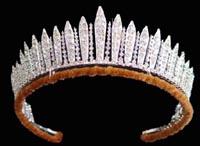
Before the first world war, tiaras were still
de rigueur however the social upheaval at the time caused many of these
beautiful gems to be quietly put away until different times came; when so
many had given their lives, the obvious flaunting of wealth by the wearing
of a superfluous jewel was considered slightly dangerous. Brides took to
wearing head-dresses made of lace, of flowers, or perhaps just a veil.
A brief period of sparkling brightness occurred
during the twenties when hair jewels were back in vogue and alongside the
beading and glamour of the dresses, long flapper style necklaces and bandeau
of silk with a brooch of glittering and beautiful intensity might have been
pinned in the hair.
Alongside the evocative jewels of the Art Deco period, austerity and financial
ruin caused by the stock market crash in the 1930's must have led many leading
families to quietly sell their jewels and tiaras which would more than likely
have been broken down into their component parts of precious metals and
jewels and have been recycled into more affordable gems - we will never
know how many important jewels were subjected to this fate.
The 30's, 40's and 50's, effectively war years again gave
way to radical social change - whilst men were dying on far off shores,
jewelled magnificence was rarely glimpsed other than at social and state
occasions such as the crowning of Queen Elizabeth which gave rise to an
occasion resplendent with ermine and diamonds - though the average bride
at this time would be wearing a hat with a veil rather than a jewelled headpiece,
and so tiaras fell out of favour - 1958 saw the last debutantes presented
at court, the last formal wearing of tiaras for presentation to the queen
whilst wearing white dresses, impressive jewels and white feathers ended
for ever.
The 1960's and 1970's were periods of swinging modernity, where a bride
would often wear white leather knee boots with her white mini wedding dress,
where short hair and simplicity measured the fashions of the day - could
you imagine the bride's horror if something as old, as ornamented as a tiara
had been mentioned? Fashion was looking forward rather than backwards, and
everything old was out.
The 1980's brought a return to glamour, power suits, high hair and big,
big jewels brought back glittering fashion and it was not unusual to see
brides returning to large, lace trimmed style dresses, huge and opulent
wedding bouquets, the outfit being finished off with a sparkling Swarovski
or (for the lucky few) a family heirloom diamond tiara; the defining moment
of 1980's bridal tiaras was the 1981 wedding of Diana Spencer to the Prince
of Wales.
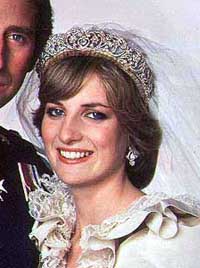
Above and below - Diana
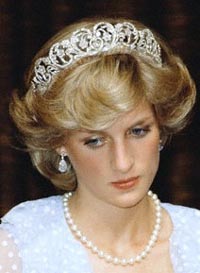
Although the 1990's seemed to be bent on rejecting the high living of the
1980's and young women were seen wearing 'grunge', almost as a antedote
to the grey utilitarian day to day fashion, wedding wear did not reflect
this and brides often wore sophisticated, costly sleek satin dresses of
cream and white, the wearing of a sparking head-dress was a natural accessory.
Today, the wearing of colour in wedding dresses, in bouquets, in head-dresses
is not frowned on - where a woman in Victorian days would wear her best
dress whether it be green, blue or pink, today's bride will not balk at
wearing a dress which might include black brocade, or a corset of green
velvet with her cream satin skirts...this offers the tiara designer ultimate
leeway, no longer must tiaras be silver or gold with a few sparkles, often
the addition of colour can signify a special meaning to the bride and her
family.
Head-dresses have come full circle, styles
and shapes and colours are constantly evolving, tiaras today are the treasured
memento of a special day, being passed on to sister, best friend or daughter
along the way.
My own creative evolution has progressed
from formal silver and gold on to what I consider the most meaningful of
all of this head-dress - the incorporation of vintage or antique pieces
of jewellery, sometimes several pieces in one head-piece; my 'Heirloom Tiaras'.
Because of the vagaries of obtaining such jewellery, each one is individual
- I especially love to consider the woman how has loved and worn the original
piece, who has treasured and preserved it until the present day when it
finds its way into my hands, and from there in the form of a future heirloom
as a tiara.
Above - Flora Heirloom Tiara
![]()
Tiara - Dictionary Definition: –noun
1. A jewelled, ornamental coronet worn by women.
2. Roman Catholic Church. a head-piece consisting of three coronets on top
of which is an orb and a cross, worn by the pope, or carried before him
during certain non-liturgical functions.
3. The position, authority, and dignity of the pope.
4. A high headdress, or turban, worn by the ancient Persians and others.
Origin: 1545–55; headdress - a kind of turban
![]()
Interesting web sites:
http://www.royal-magazin.de/england/index.htm
http://penelope.uchicago.edu/Thayer/E/Roman/Texts/secondary/SMIGRA*/Corona.html
http://www.royalcollection.org.uk/
Books you may find informative: Munn, Geoffrey C, Tiaras Past and Present
Munn, Geoffrey C, Tiaras A History of Splendour
Scarisbrick, Diana, Tiara
All
Content, Design, Text and Photographs Copyright Stephanie Lewis-Cooper
www.beadaddict.com,
www.tiaraonline.co.uk, www.slcdesigns.com™, 2002-2009